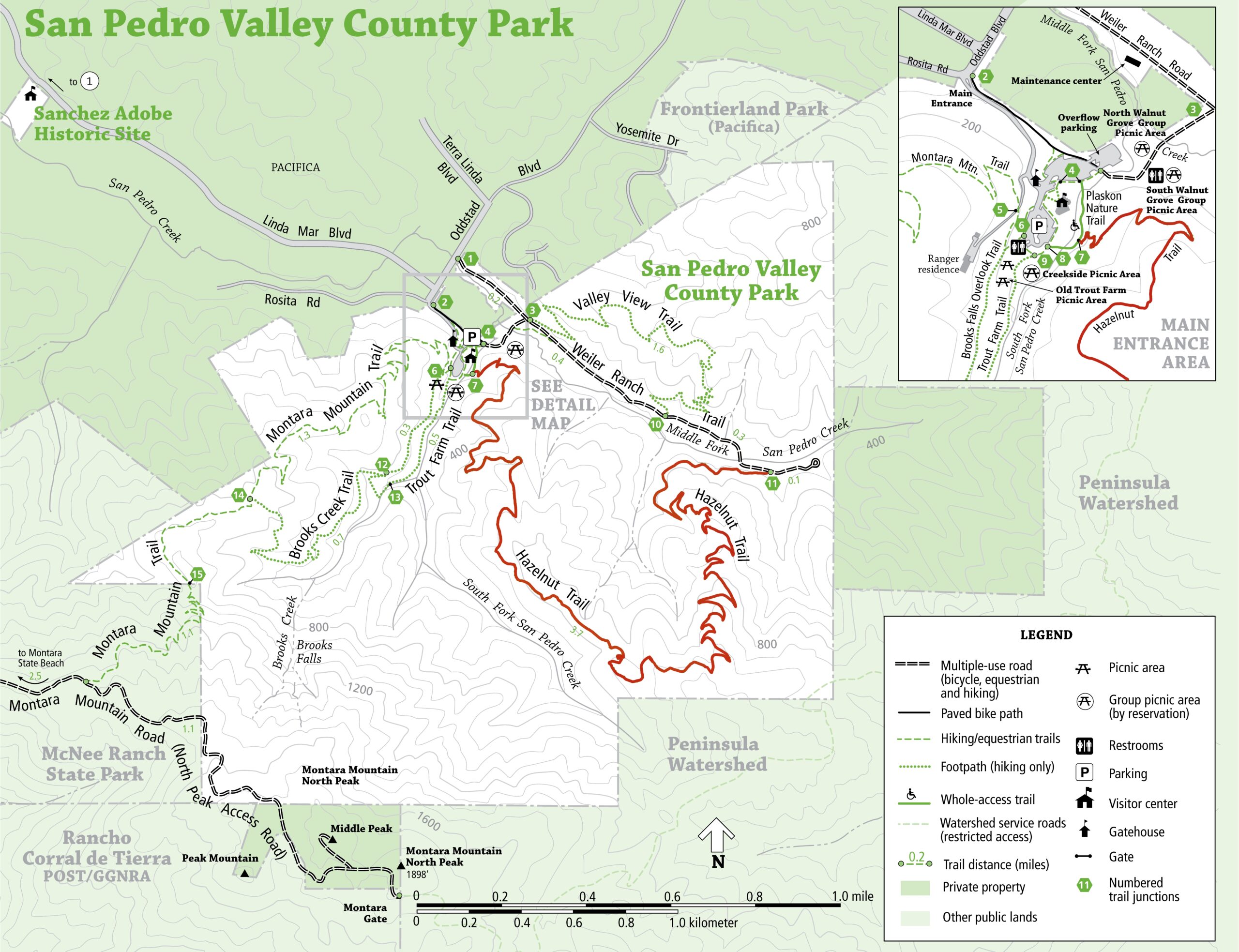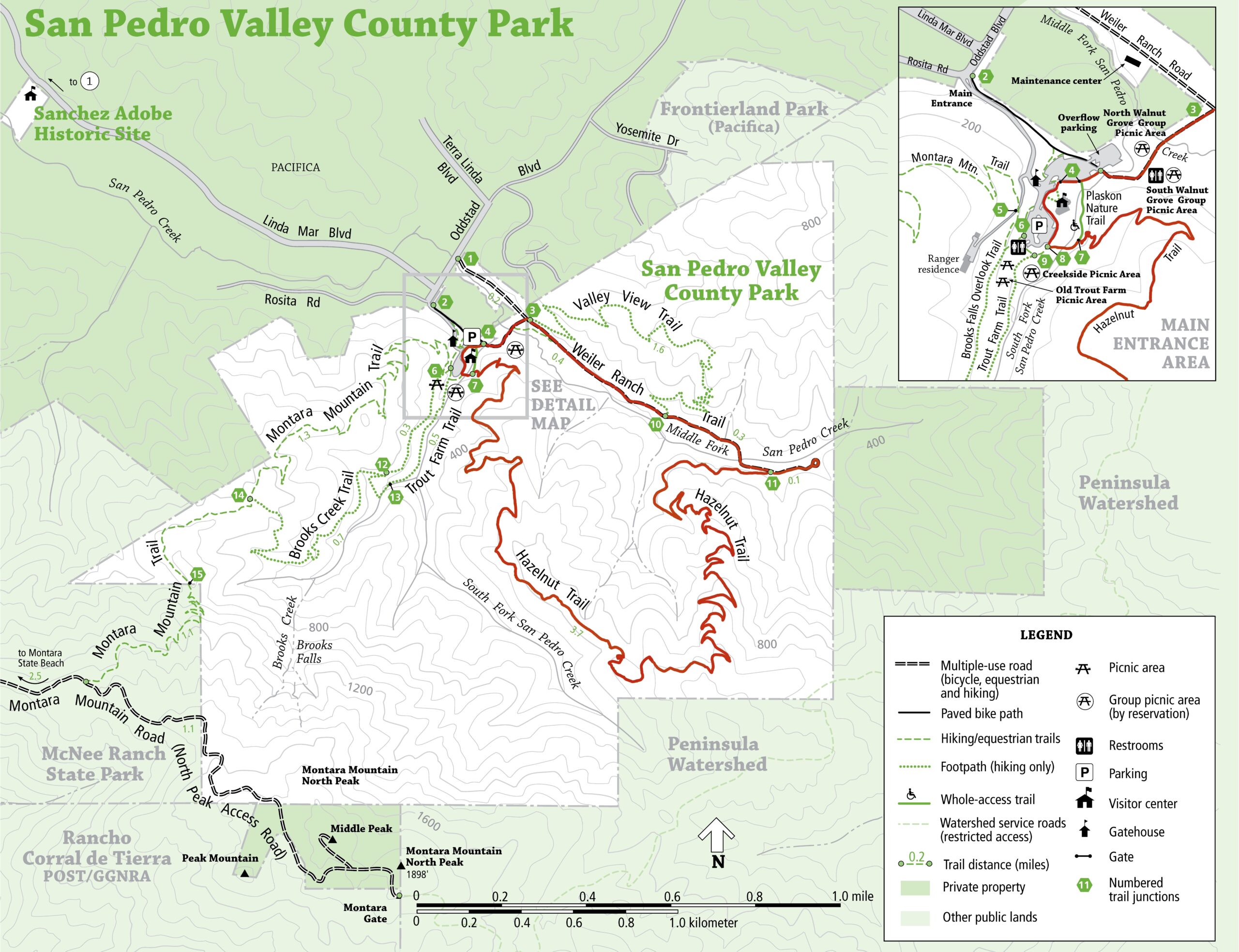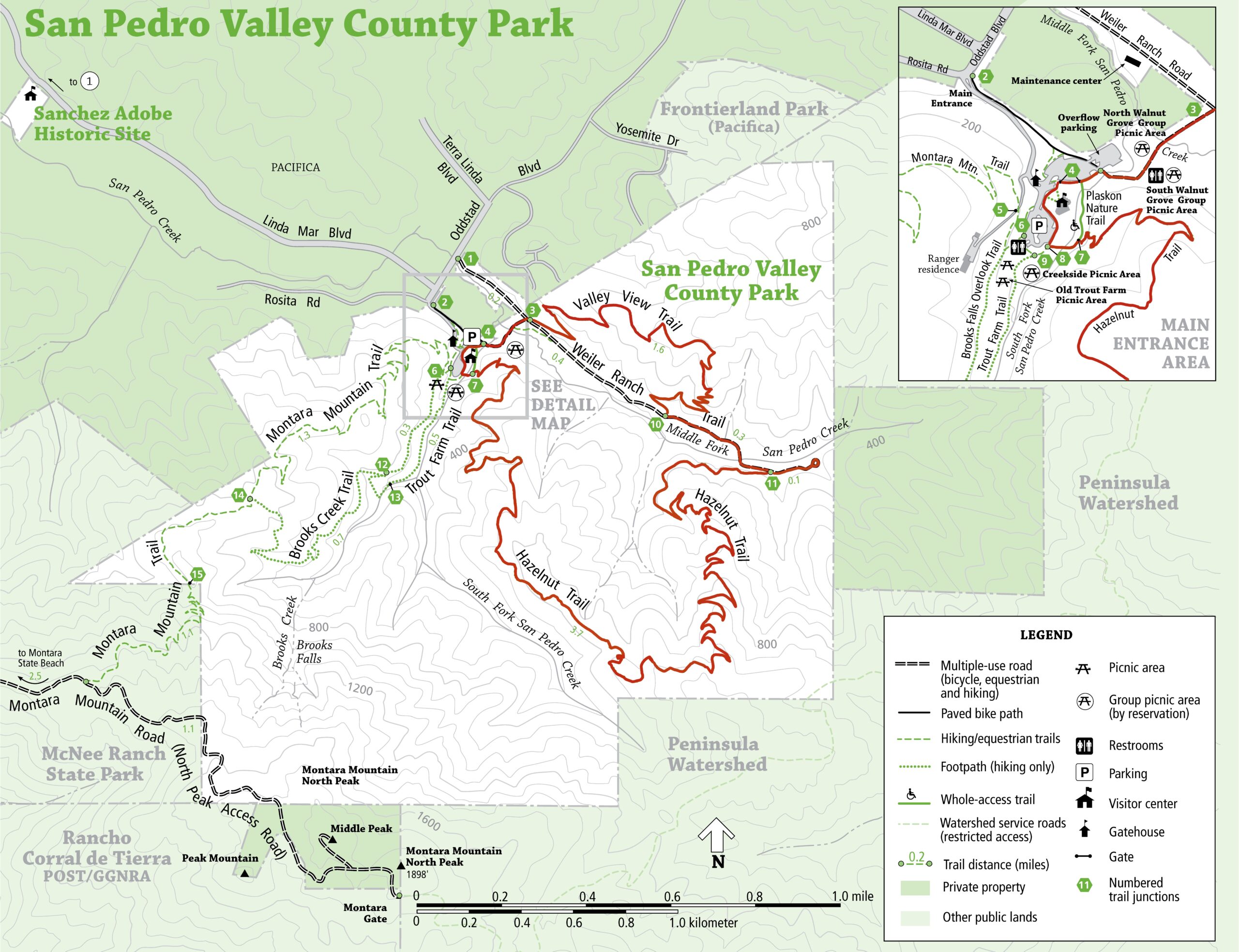
Trails
Hazelnut Trail
Distance: 3.7mi / 5.96km
Gain: 866ft / 264m
Minimum estimated time: ~1 hour 56 minutes
Difficulty: Strenuous
Text & Photos by Bing Huey
The Hazelnut Trail begins, at its western terminus, near the south end of Plaskon Trail and Creekside Picnic Area, and extends to the east end of the valley of middle San Pedro Creek, where it intersects the Weiler Ranch Trail. For the hiker, it connects the valleys of the south and middle forks of San Pedro Creek, in the process traversing the intervening hillside. Combined with Weiler Ranch Trail, the Hazelnut forms a loop, returning to the Visitor Center area in a distance of approximately 4.5 miles. It takes the hiker through a variety of plant communities, where some of the park’s greatest numbers of native plants and their habitats can be viewed, both up-close and in the distance.
Starting the hike from the west side, near the Visitor Center, one crosses the bridge over the south fork of San Pedro Creek to find the trailhead. The trail climbs from the shaded creekside through a grove of magnificent coast live oak. Possible remnants of a once more extensive oak grassland, the lichen-draped trees now form a shaded habitat that hosts, among other things, various fungi during the wet season and the early spring appearance of the distinctive fetid adder’s tongue. In the Spring one might stop at the moist shaded habitat near the creek to look for blooms of fringe cups and alum root. Scattered coast live oak are seen growing elsewhere, but have to compete for space with more dominant scrub species. Farther up the trail are two areas of open meadow that have not been overgrown by the coastal scrub. The survival of these is at least partially aided by the efforts of park volunteers who help thin out the encroaching brush at their edges. In Spring the meadows have nice displays of annuals such as Douglas irises, sun cups, and mission bells.
As the trail ascends it passes more of the dense vegetation of coastal scrub, characterized with plants such as coffeeberry, huckleberry, toyon, ocean spray, coyote bush, and, of course, California hazelnut. There is the occasional madrone, prominently orange in color and usually taller than surrounding plants. Spring annuals, such as cow parsnip, Indian paintbrush, yarrow, pearly everlasting, and blue-witch make their appearance in abundance. Throughout the growing season, vine-growing plants, such as manroot, honeysuckle, morning glory and its look-alike non-native, coast bindweed, are seen climbing the perennials. Also ubiquitous are blackberry and poison oak.
Along much of the Hazelnut up to its apex, one can view south across the valley of south San Pedro Creek and see the north flanks of Montara Mountain, with its lush growth of almost pure native coastal scrub and chaparral. Soaring turkey vultures are seen year-round above the valley. Other birds are less visible than audible, like the wrentit, one of the most common, who stays under cover of the shrubs but betrays its presence with a distinctive call that has been compared to the increasing frequency of a bouncing ping-pong ball. Raucous Stellar’s jays or scrub jays are seen and heard. Experienced birders may try to catch sight of the dark-eyed junco, purple finch, Bewick’s wren, downy woodpecker, olive-sided flycatcher, or Hutton’s vireo.
The trail climbs farther to enter a eucalyptus grove, where there is a bench and vistas of Linda Mar and the Pacific Ocean. Not far past this one enters a fairly homogeneous stand of manzanita. Both the brittle-leaf manzanita and the rare endemic Montara manzanita are seen here. These woody shrubs are characteristic of one type of chaparral plant group that occur in the Park and on Montara Mountain, and are seen elsewhere along the trail. When in bloom during the winter and early spring, hummingbirds can be seen in proximity, feeding on the nectar. Elsewhere in the Park, other chaparral-type plants, such as hazelnut, ocean spray, blue blossom, and chinquapin, appear to dominate.
The trail passes through more stands of eucalyptus before climbing to its highest point, about 800 feet in elevation, whereupon it descends into the shaded north face of the hillside. The vegetation changes to reflect this, becoming types more tolerant of the shade and coolness. There is increased abundance of ferns, thimbleberry, wild rose, and star flower. Following the trail as it descends by switchbacks one can look across the valley to the opposite south-facing slope to see the contrasting vegetation in the hotter, dryer microclimate. There, more drought-tolerant shrubs such as coyote bush and California sagebrush dominate among patches of grassy areas. Along the Hazelnut Trail the shaded areas are where some of the earlier blooming wildflowers, such as milkmaids, hound’s tongue, flowering currant, and trillium, appear beginning in late Winter.
The trail ends just as it reaches the valley floor and meets the riparian habitat of middle San Pedro Creek. From the bridge one can view the creek bordered by willow and red alder, along with dense stands of willow and coast dogwood. Taking a left here to return along the Weiler Ranch Trail one can look for the osoberry, with its smallish white blossoms, and the California burning bush, with its dark red blossom ripening to striking orange and purple berries.
The Hazelnut Trail is one to be be enjoyed by the season. With plant list in hand the interested naturalist can hike any part of the trail and observe various species through the seasons, or observe the myriad animal life whose existence is vitally connected with the flora, deriving from it food and shelter. These range from invertebrates, such as insects and spiders, to seasonal and permanent birds, snakes and lizards, and mammals such as black-tailed deer, bush rabbit, coyote, fox, and bobcat.
Recommended Trail Loops:
Hazelnut Trail > Weiler Ranch Trail Loop
Distance: 4.96mi / 7.98km
Gain: 913ft / 278m
Minimum estimated time: ~2 hours 17 minutes
Difficulty: Strenuous
Hazelnut Tr. > Weiler Ranch Tr. > Valley View Tr. Loop
Distance: 6.04mi / 9.72km
Gain: 1,276ft / 389m
Minimum estimated time: ~3 hours 4 minutes
Difficulty: Strenuous
The minimum estimated hiking times are based on Naismith’s rule :
“Allow one hour for every 3 miles (5 km) forward, plus an additional hour for every 2,000 feet (600 m) of ascent.”








